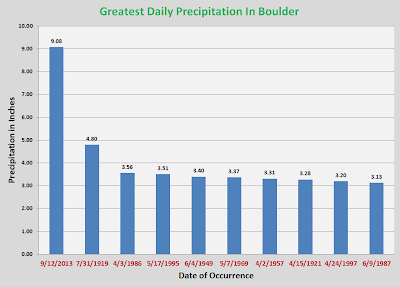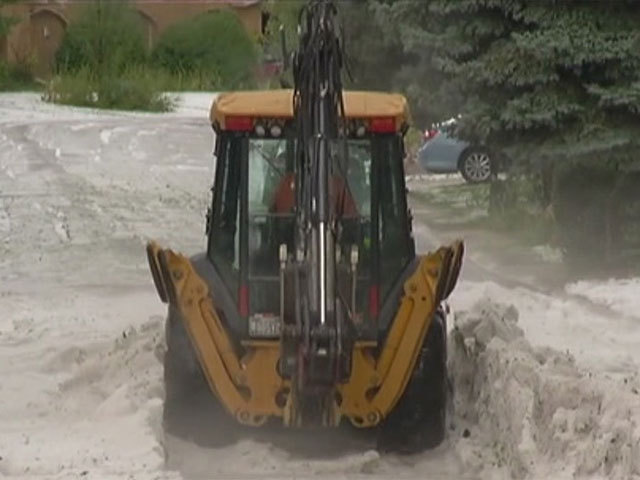It didn't take long for Boulder to set a new annual rainfall record - one day, in fact. Boulder received another 1.0 to 2.70 inches of rain in the 24-hour period ending this morning, with 1.94 inches recorded at the U.S. Cooperative Network station. That brings the September total to 16.69 inches of rain for the month, and the annual total - so far - to 29.65 inches for the year to date. That amount breaks the old record of 29.43 set in 1995, and it will only go up from there. The 16.69 inches of rain at the Coop site is far from the highest in the Boulder area. Eight CoCoRaHS observers have more rain during the month, with two observers reporting more than 20 inches. The observer at CO-CO-33 (Boulder 3.3 SE) has received 21.15 inches in September. Boulder was not alone in getting more unwanted rain yesterday. One to two inch amounts were recorded from Colorado Springs north to Fort Collins.

The rain hampered rescue and recovery operations for the flooding. The flooding in Colorado has already claimed seven lives and an estimated 1,200 people are unaccounted for. Only scattered "pop-up" showers and thunderstorms are expected along the front Range the next 36 hours, with dry weather the rest of the week.
While most of the attention has been focused on Colorado, the same weather pattern resulted in heavy rain and flooding in New Mexico this past week. Some locations have received more than 10 inches of rain, with the CoCoRaHS observer at NM-ED-18 (Carlsbad 33.3 WSW) picking up 11.39 inches of rain in a three-day span.
 |
| 7-day precipitation ending 6:00 am MDT on 9/16/2013 |

Recall that New Mexico earlier this summer was
ground zero for the drought in the west . Drought is still pervasive across the state, although conditions have improved since June.
The rain this week resulted in heavy runoff swelling rivers and streams. Albuquerque has received 3.35 inches of rain this month, three times normal. It is also the wettest September on record, breaking the old record of 3.31 inches in 1929. The normal annual precipitation for Albuquerque is only 9.45 inches.
Saturated soils and runoff have contributed to flooding of low lying areas, and floodwaters have broken through dams, inundating neighborhoods and leaving behind mud and debris. The flooding forced evacuations in some areas, and flooding on the Gila River closed the Gila Cliff Dwellings National Monument. There was one fatality attributed to the flooding.
The rain has put a big dent in the drought, but it will need to be sustained over a longer period to begin to turn things around. Here are two water balance charts for CoCoRaHS station NM-BR-56 (near Albuquerque). The first shows the balance beginning August 1st. Rain over the last 45 days has brought a significant improvement in short term conditions.
If we extend the water balance chart back to May 15, the improvement is not nearly as remarkable. Since May 15 the water balance (precipitation minus evaporation) is -15.40 inches, and it will take much more rain over a longer period to eat away at that deficit.




































